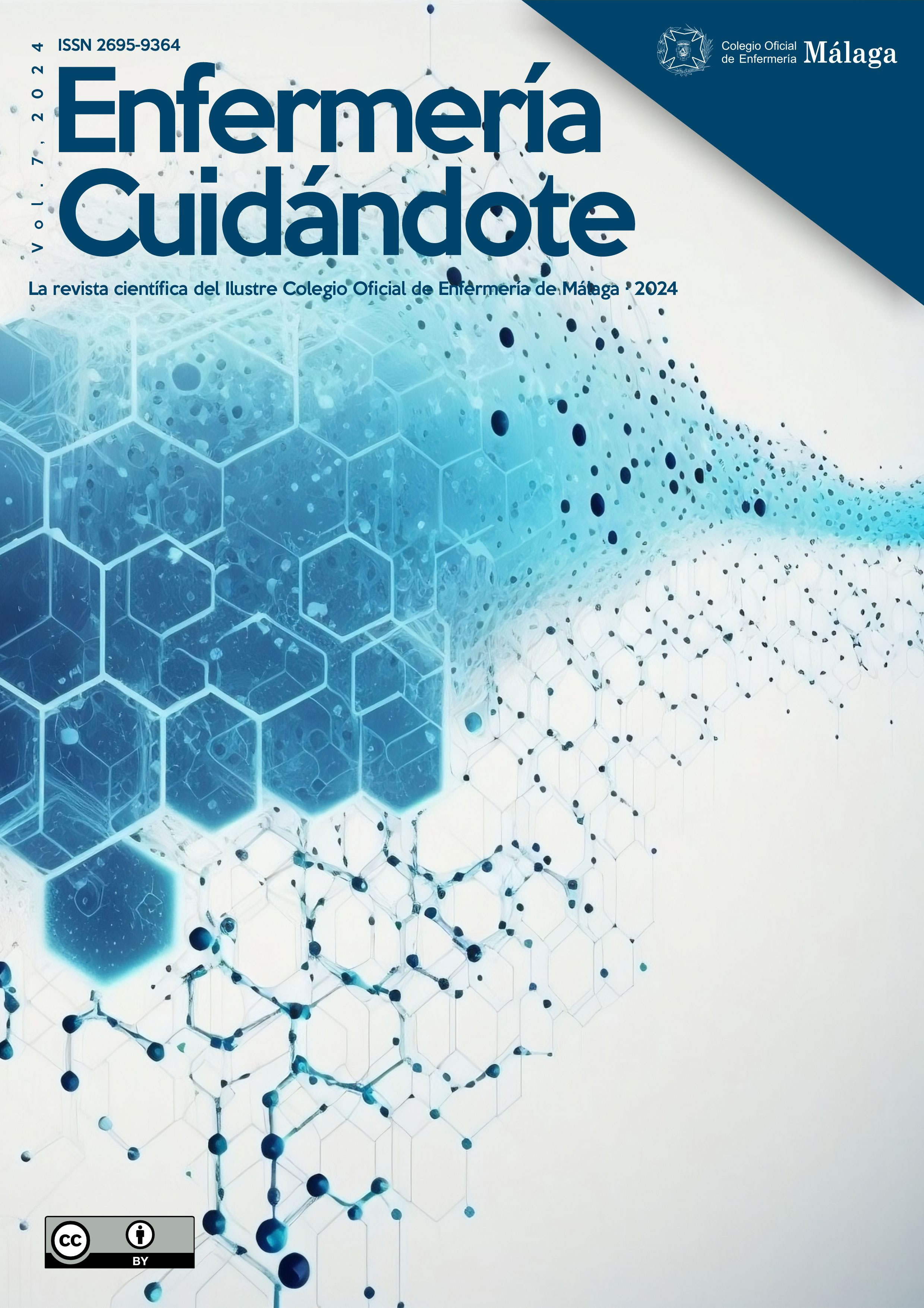Factores relacionados con el ingreso a UCI postoperatoria en pandemia en un Hospital de Medellín, Colombia
DOI:
https://doi.org/10.51326/ec.7.2752698Palabras clave:
Atención Perioperativa, Atención de Enfermería, COVID-19, Hipotensión, Periodo Perioperatorio, Unidades de Cuidados Intensivos, VasoconstrictoresResumen
Introducción: Durante la pandemia por COVID-19 fue necesaria la redistribución organizacional pensando en la seguridad de los pacientes, así como el disponer de recursos, tales como infraestructura, tecnológicos y humanos, para la atención en salud debido al aumento considerable de pacientes críticos infectados por Covid-19.
Objetivo: Identificar los factores relacionados con el ingreso a la UCI en el perioperatorio durante la pandemia de COVID-19 en pacientes sin infección confirmada o con sospecha de SARS-CoV-2.
Materiales y métodos: Se analizaron 178 pacientes quirúrgicos operados durante el año 2020, en una Institución prestadora de servicios de alto nivel de complejidad. Se evaluaron variables como la presión diastólica preoperatoria, presión diastólica post anestésica, tiempo total de anestesia, tipo de cirugía y frecuencia cardiaca post anestesia. Se utilizaron registros médicos y datos retrospectivos de los pacientes.
Resultados: Se encontró que la mediana de días de oportunidad quirúrgica fue de 6 días, con un 15% de cancelación de cirugías debido al requerimiento de UCI en el posoperatorio. Hubo una diferencia estadísticamente significativa en la presión arterial diastólica preoperatoria entre los pacientes con ingreso a UCI (mediana: 73 mmHg) y aquellos sin ingreso a UCI (mediana: 83 mmHg) (p: 0.007).
Conclusión: Los factores que estuvieron relacionados con el ingreso a UCI en los pacientes postoperatorio en pandemia fueron: encontrando asociación estadísticamente significativa entre las cirugías urgentes, las presiones diastólicas bajas antes y después de la anestesia, el tiempo total de anestesia y la frecuencia cardiaca elevada posanestésica.
Descargas
Citas
Puppo Moreno AM, Abella Álvarez A, Morales Conde S, Pérez Flecha M, García Ureña MÁ. La unidad de cuidados intensivos en el postoperatorio de cirugía mayor abdominal. Med Intensiva. 2019;43(9):569-77. https://doi.org/10.1016/j.medin.2019.05.007
World Health Organization. WHO guidelines for safe surgery 2009: safe surgery saves lives. Safe surgery saves lives. Geneva: World Health Organization; 2009. Disponible en: https://apps.who.int/iris/handle/10665/44185 [Consultado 13-07-2023]
Joint Commission Internationalf. Accreditation Standards for Hospitals Including Standards for Academic Medical Center Hospitals. 7th ed. Vol. 1. Oakbrook Terrace (Ill.): Joint Commission International; 2020.
Weiser TG, Regenbogen SE, Thompson KD, Haynes AB, Lipsitz SR, Berry WR, et al. An estimation of the global volume of surgery: a modelling strategy based on available data. Lancet. 2008;372(9633):139-44. https://doi.org/10.1016/s0140-6736(08)60878-8
Pearse RM, Harrison DA, James P, Watson D, Hinds C, Rhodes A, et al. Identification and characterisation of the high-risk surgical population in the United Kingdom. Crit Care. 2006;10(3):R81. https://doi.org/10.1186/cc4928
Ghaffar S, Pearse RM, Gillies MA. ICU admission after surgery: who benefits? Curr Opin Crit Care. 2017;23(5):424-9. https://doi.org/10.1097/mcc.0000000000000448
COVIDSurg Collaborative. Elective surgery cancellations due to the COVID-19 pandemic: global predictive modelling to inform surgical recovery plans. Br J Surg. 2020;107(11):1440-9. https://doi.org/10.1002/bjs.11746
COVIDSurg Collaborative. Global guidance for surgical care during the COVID-19 pandemic. Br J Surg. 2020 Aug;107(9):1097-1103. https://doi.org/10.1002/bjs.11646
American College of Surgeons. COVID-19: Elective Case Triage Guidelines for Surgical Care [Internet]. Chicago (Ill.): American College of Surgeons; 2020. Disponible en: https://www.facs.org/media/wfjhq0jw/guidance_for_triage_of_nonemergent_surgical_procedures.pdf [Consultado 13-07-2023]
Søreide K, Hallet J, Matthews JB, Schnitzbauer AA, Line PD, Lai PBS, et al. Immediate and long-term impact of the COVID-19 pandemic on delivery of surgical services. Br J Surg. 2020;107(10):1250-61. https://doi.org/10.1002/bjs.11670
El-Saiedi SA, Haeffele C, Hanna BM, Lui GK. The Hidden Victims of the COVID-19 Pandemic: Congenital Heart Disease Patients. JACC Case Rep. 2020;2(9):1411-3. https://doi.org/10.1016/j.jaccas.2020.05.081
Civantos FJ, Leibowitz JM, Arnold DJ, Stubbs VC, Gross JH, Thomas GR, et al. Ethical surgical triage of patients with head and neck cancer during the COVID-19 pandemic. Head Neck. 2020;42(7):1423-47. https://doi.org/10.1002/hed.26229
Huang WW, Zhu WZ, Mu DL, Ji XQ, Li XY, Ma D, et al. Intraoperative hypotension is associated with shortened overall survival after lung cancer surgery. BMC Anesthesiology. 2020;20(1):160. https://doi.org/10.1186/s12871-020-01062-2
Weingart S. Push-dose pressors for immediate blood pressure control. Clin Exp Emerg Med. 2015;2(2):131-2. https://doi.org/10.15441/ceem.15.010
Sessler DI, Meyhoff CS, Zimmerman NM, Mao G, Leslie K, Vásquez SM, et al. Period-dependent Associations between Hypotension during and for Four Days after Noncardiac Surgery and a Composite of Myocardial Infarction and Death: A Substudy of the POISE-2 Trial. Anesthesiology. 2018;128(2):317-27. https://doi.org/10.1097/aln.0000000000001985
Bijker JB, van Klei WA, Kappen TH, van Wolfswinkel L, Moons KG, Kalkman CJ. Incidence of intraoperative hypotension as a function of the chosen definition: literature definitions applied to a retrospective cohort using automated data collection. Anesthesiology. 2007;107(2):213-20. Disponible en: https://journals.lww.com/anesthesiology/fulltext/2007/08000/incidence_of_intraoperative_hypotension_as_a.6.aspx [Consultado 19-07-2023]
Lonjaret L, Lairez O, Minville V, Geeraerts T. Optimal perioperative management of arterial blood pressure. Integr Blood Press Control. 2014;7:49-59. https://doi.org/10.2147/ibpc.s45292
Latif JA, Lorenzo MJ, Solla R, Segovia G, Mitidieri A, Coturel A, et al. COVID-19 y cirugía. Impacto en los volúmenes de atención, complicaciones posoperatorias y mortalidad. Resultados después de un año de pandemia. Rev Argent Cir. octubre de 2022;114(4):307-16. http://dx.doi.org/10.25132/raac.v114.n4.1671
Grasselli G, Greco M, Zanella A, Albano G, Antonelli M, Bellani G, et al. COVID-19 Lombardy ICU Network. Risk Factors Associated With Mortality Among Patients With COVID-19 in Intensive Care Units in Lombardy, Italy. JAMA Intern Med. 2020;180(10):1345-55. https://doi.org/10.1001/jamainternmed.2020.3539. Erratum in: JAMA Intern Med. 2021;181(7):1021. https://doi.org/10.1001/jamainternmed.2021.1229
Martínez-Pillado M, Said-Criado I, Regueiro-Martínez A, Varela-Durán M, Baltar Boileve D, Solas Gaspar O. Evaluación de los planes de contingencia en la atención a pacientes en Unidades de Cuidados Intensivos en la pandemia por COVID-19. J Healthc Qual Res. 2022t;37(5):291-8. https://doi.org/10.1016/j.jhqr.2021.12.009
Sztajnbok J, Ribeiro AF, Malaque CMSA, Cavalin RF, Lanza MP, Souza NFC, et al. Intensive care unit staff preparedness as an independent factor for death of patients during COVID-19 pandemic: An observational cohort study. Braz J Infect Dis. 2021;25(6):101653. https://doi.org/10.1016/j.bjid.2021.101653
Barranquero AG, Ramos D, Ocaña J, Puerta A, Tabanera AV, Bajawi M, et al. Baja incidencia y alta mortalidad por COVID-19 en Cirugía General durante la primera ola de la pandemia. Rev Cir. 2021;73(3):314-21. http://dx.doi.org/10.35687/s2452-454920210031242
Knochel K, Adaktylos-Surber K, Schmolke EM, Meier LJ, Kuehlmeyer K, Ulm K, et al. Preparing for the Worst-Case Scenario in a Pandemic: Intensivists Simulate Prioritization and Triage of Scarce ICU Resources. Crit Care Med. 2022;50(12):1714-24. https://doi.org/10.1097/ccm.0000000000005684
Peters AW, Chawla KS, Turnbull ZA. Transforming ORs into ICUs. N Engl J Med. 2020;382(19):e52. https://doi.org/10.1056/nejmc2010853
Sociedad Española de Medicina Intensiva, Crítica y Unidades Coronarias. Actores y recomendaciones generales relacionados con la adecuación asistencial y la ética de las decisiones ante situaciones excepcionales de crisis en las unidades de cuidados intensivos. [Madrid]: Sociedad Española de Medicina Intensiva, Crítica y Unidades Coronarias; [Fecha desconocida]. Disponible en: https://www.fesemi.org/sites/default/files/documentos/publicaciones/etica-semicyuc-covid-19-tablas.pdf [Consultado 19-07-2023]
Jhanji S, Thomas B, Ely A, Watson D, Hinds CJ, Pearse RM. Mortality and utilisation of critical care resources amongst high-risk surgical patients in a large NHS trust. Anaesthesia. 2008;63(7):695-700. https://doi.org/10.1111/j.1365-2044.2008.05560.x
García-Uribe J, Lopera-Jaramillo D, Gutiérrez-Vargas J, Arteaga-Noriega A, Bedoya OA. Adverse effects related with norepinephrine through short peripheral venous access: Scoping review. Enferm Intensiva (Engl Ed). 2023;34(4):218-26. https://doi.org/10.1016/j.enfie.2022.09.001
Garcia-Uribe JC, Chavarría-Ramírez VC. Mortalidad infantil en Antioquia durante el año 2021: hacia un enfoque sindémico. Rev Cienc Cuid. 20(2):36-50. https://doi.org/10.22463/17949831.3690
Jarzebowski M, Curran T, Dorsey M, Cederquist W, Claar D, Derrig E, et al. Creating an Intensive Care Unit From a Postanesthesia Care Unit for the COVID-19 Surge at the Veterans Affairs Ann Arbor Healthcare System. Fed Pract. 2020;37(8):348-53. https://doi.org/10.12788/fp.0020
García-Uribe JC, Espinal-Espinal LA, Canestero-Montoya IC, Henao-Villegas S, Garzón-Duque MO. Tensiones éticas, causas y consecuencias del síndrome de burnout en el personal de salud en tiempos de la Covid-19: una revisión y análisis desde la bioética. Rev Latinoam Bioét. 2023;23(1):61-84. https://doi.org/10.18359/rlbi.5816




















